display RENAULT SCENIC 2011 J95 / 3.G Engine And Peripherals Siemens Injection Workshop Manual
[x] Cancel search | Manufacturer: RENAULT, Model Year: 2011, Model line: SCENIC, Model: RENAULT SCENIC 2011 J95 / 3.GPages: 329, PDF Size: 1.71 MB
Page 3 of 329

13B-3
MR-372-J84-13B050$039.mif
V17
DIESEL INJECTION
Fault finding – Introduction
Siemens Injection
SID301 and 304
Vdiag No.: 44-45-48-49-4D-4C
Program No.: B1 and B2
13B
For vehicles with key/radio frequency remote control, use the key to switch off the ignition.
For vehicles with a Renault card:
– press the Start button twice briefly (less than 3 seconds),
– ensure that the + after ignition feed has been cut off by checking that the computer warning lights on the
instrument panel have gone out.
Faults
Faults are declared present or stored (depending on whether they appeared in a certain context and have
disappeared since, or whether they remain present but are not diagnosed within the current context).
The present or stored status of faults should be considered when using the diagnostic tool after the + after ignition
feed is switched on (without any action on the system components).
For a present fault, apply the procedure described in the Interpretation of faults section.
For a stored fault, note the faults displayed and apply the instructions in the Notes section.
If the fault is confirmed when the instructions are applied, the fault is present. Deal with the fault.
If the fault is not confirmed, check:
– the electrical lines which correspond to the fault,
– the connectors on these lines (corrosion, bent pins, etc.),
– the resistance of the faulty component,
– the condition of the wires (melted or split insulation, wear).
Conformity check
The aim of the conformity check is to check data that does not produce a fault on the diagnostic tool when the
data is inconsistent. Therefore, this stage is used to:
– carry out fault finding on faults that do not have a fault display, and which may correspond to a customer
complaint,
– check that the system is operating correctly and that there is no risk of a fault recurring after repairs.
This section gives the fault finding procedures for statuses and parameters and the conditions for checking them.
If a status is not behaving normally or a parameter is outside the permitted tolerance values, consult the
corresponding fault finding page.
Customer complaints - Fault finding chart
If the test with the diagnostic tool is OK but the customer complaint is still present, the fault should be processed
bycustomer complaints.
A synopsis of the general procedure to follow is provided on the following page in the
form of a flow chart.
Page 18 of 329
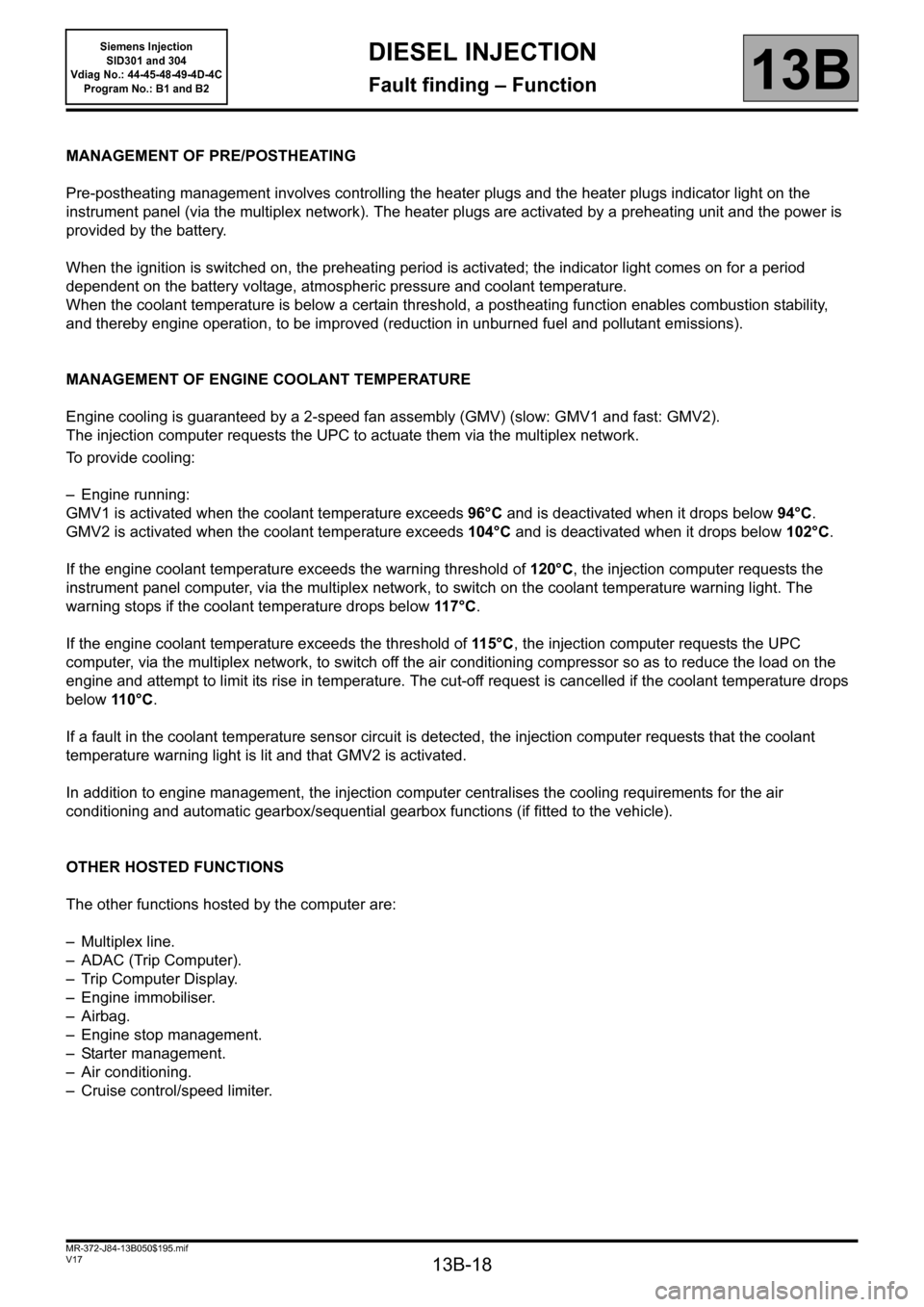
13B-18
MR-372-J84-13B050$195.mif
V17
Siemens Injection
SID301 and 304
Vdiag No.: 44-45-48-49-4D-4C
Program No.: B1 and B2DIESEL INJECTION
Fault finding – Function13B
MANAGEMENT OF PRE/POSTHEATING
Pre-postheating management involves controlling the heater plugs and the heater plugs indicator light on the
instrument panel (via the multiplex network). The heater plugs are activated by a preheating unit and the power is
provided by the battery.
When the ignition is switched on, the preheating period is activated; the indicator light comes on for a period
dependent on the battery voltage, atmospheric pressure and coolant temperature.
When the coolant temperature is below a certain threshold, a postheating function enables combustion stability,
and thereby engine operation, to be improved (reduction in unburned fuel and pollutant emissions).
MANAGEMENT OF ENGINE COOLANT TEMPERATURE
Engine cooling is guaranteed by a 2-speed fan assembly (GMV) (slow: GMV1 and fast: GMV2).
The injection computer requests the UPC to actuate them via the multiplex network.
To provide cooling:
– Engine running:
GMV1 is activated when the coolant temperature exceeds 96°C and is deactivated when it drops below 94°C.
GMV2 is activated when the coolant temperature exceeds 104°C and is deactivated when it drops below 102°C.
If the engine coolant temperature exceeds the warning threshold of 120°C, the injection computer requests the
instrument panel computer, via the multiplex network, to switch on the coolant temperature warning light. The
warning stops if the coolant temperature drops below 117 ° C.
If the engine coolant temperature exceeds the threshold of 11 5 ° C, the injection computer requests the UPC
computer, via the multiplex network, to switch off the air conditioning compressor so as to reduce the load on the
engine and attempt to limit its rise in temperature. The cut-off request is cancelled if the coolant temperature drops
below 110°C.
If a fault in the coolant temperature sensor circuit is detected, the injection computer requests that the coolant
temperature warning light is lit and that GMV2 is activated.
In addition to engine management, the injection computer centralises the cooling requirements for the air
conditioning and automatic gearbox/sequential gearbox functions (if fitted to the vehicle).
OTHER HOSTED FUNCTIONS
The other functions hosted by the computer are:
– Multiplex line.
– ADAC (Trip Computer).
– Trip Computer Display.
– Engine immobiliser.
– Airbag.
– Engine stop management.
– Starter management.
– Air conditioning.
– Cruise control/speed limiter.
Page 26 of 329
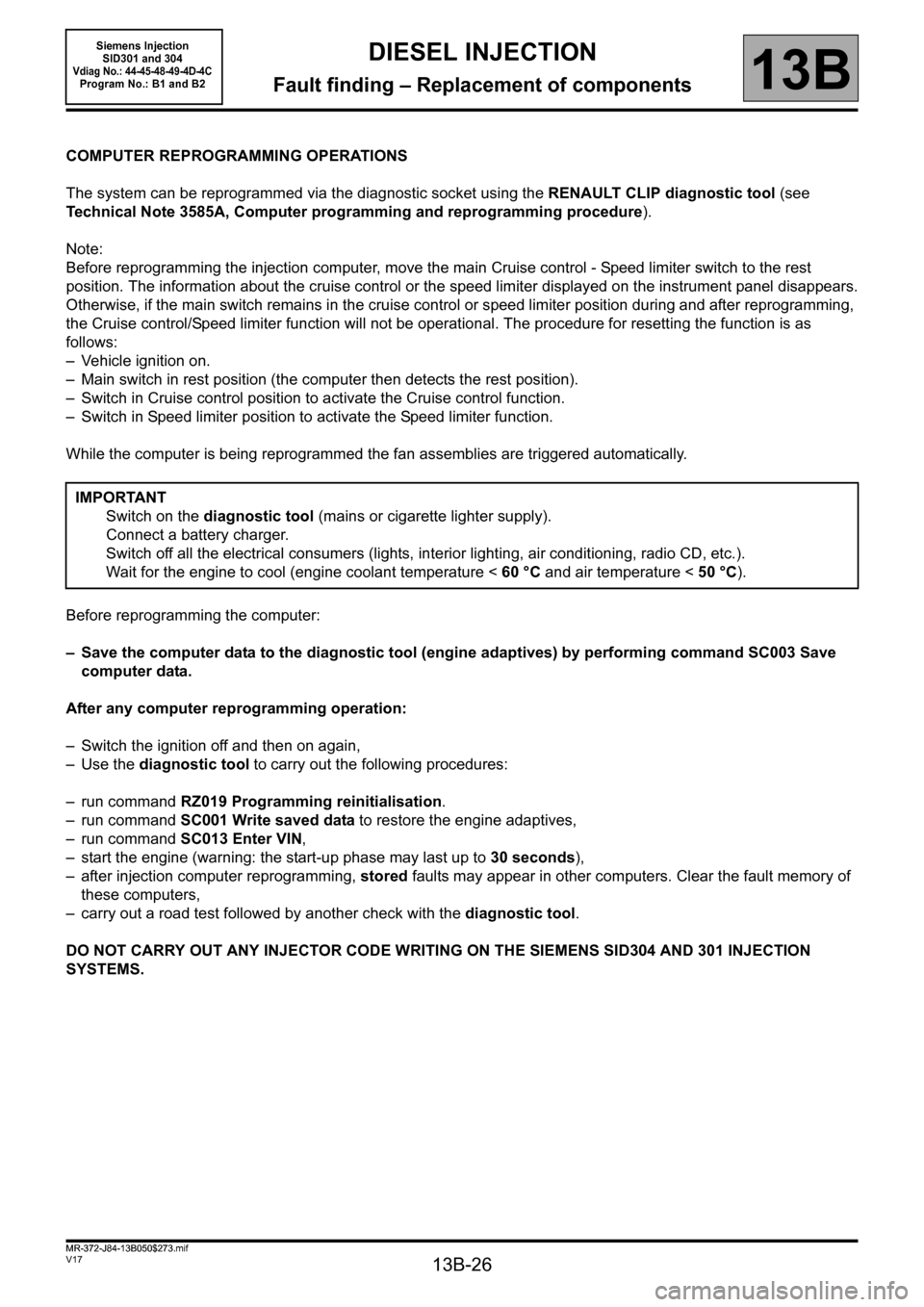
13B-26
MR-372-J84-13B050$273.mif
V17
13B
DIESEL INJECTION
Fault finding – Replacement of components
COMPUTER REPROGRAMMING OPERATIONS
The system can be reprogrammed via the diagnostic socket using the RENAULT CLIP diagnostic tool (see
Technical Note 3585A, Computer programming and reprogramming procedure).
Note:
Before reprogramming the injection computer, move the main Cruise control - Speed limiter switch to the rest
position. The information about the cruise control or the speed limiter displayed on the instrument panel disappears.
Otherwise, if the main switch remains in the cruise control or speed limiter position during and after reprogramming,
the Cruise control/Speed limiter function will not be operational. The procedure for resetting the function is as
follows:
– Vehicle ignition on.
– Main switch in rest position (the computer then detects the rest position).
– Switch in Cruise control position to activate the Cruise control function.
– Switch in Speed limiter position to activate the Speed limiter function.
While the computer is being reprogrammed the fan assemblies are triggered automatically.
Before reprogramming the computer:
– Save the computer data to the diagnostic tool (engine adaptives) by performing command SC003 Save
computer data.
After any computer reprogramming operation:
– Switch the ignition off and then on again,
–Use the diagnostic tool to carry out the following procedures:
– run command RZ019 Programming reinitialisation.
– run command SC001 Write saved data to restore the engine adaptives,
– run command SC013 Enter VIN,
– start the engine (warning: the start-up phase may last up to 30 seconds),
– after injection computer reprogramming, stored faults may appear in other computers. Clear the fault memory of
these computers,
– carry out a road test followed by another check with the diagnostic tool.
DO NOT CARRY OUT ANY INJECTOR CODE WRITING ON THE SIEMENS SID304 AND 301 INJECTION
SYSTEMS.IMPORTANT
Switch on the diagnostic tool (mains or cigarette lighter supply).
Connect a battery charger.
Switch off all the electrical consumers (lights, interior lighting, air conditioning, radio CD, etc.).
Wait for the engine to cool (engine coolant temperature < 60 °C and air temperature < 50 °C).
MR-372-J84-13B050$273.mif
Siemens Injection
SID301 and 304
Vdiag No.: 44-45-48-49-4D-4CProgram No.: B1 and B2
Page 35 of 329
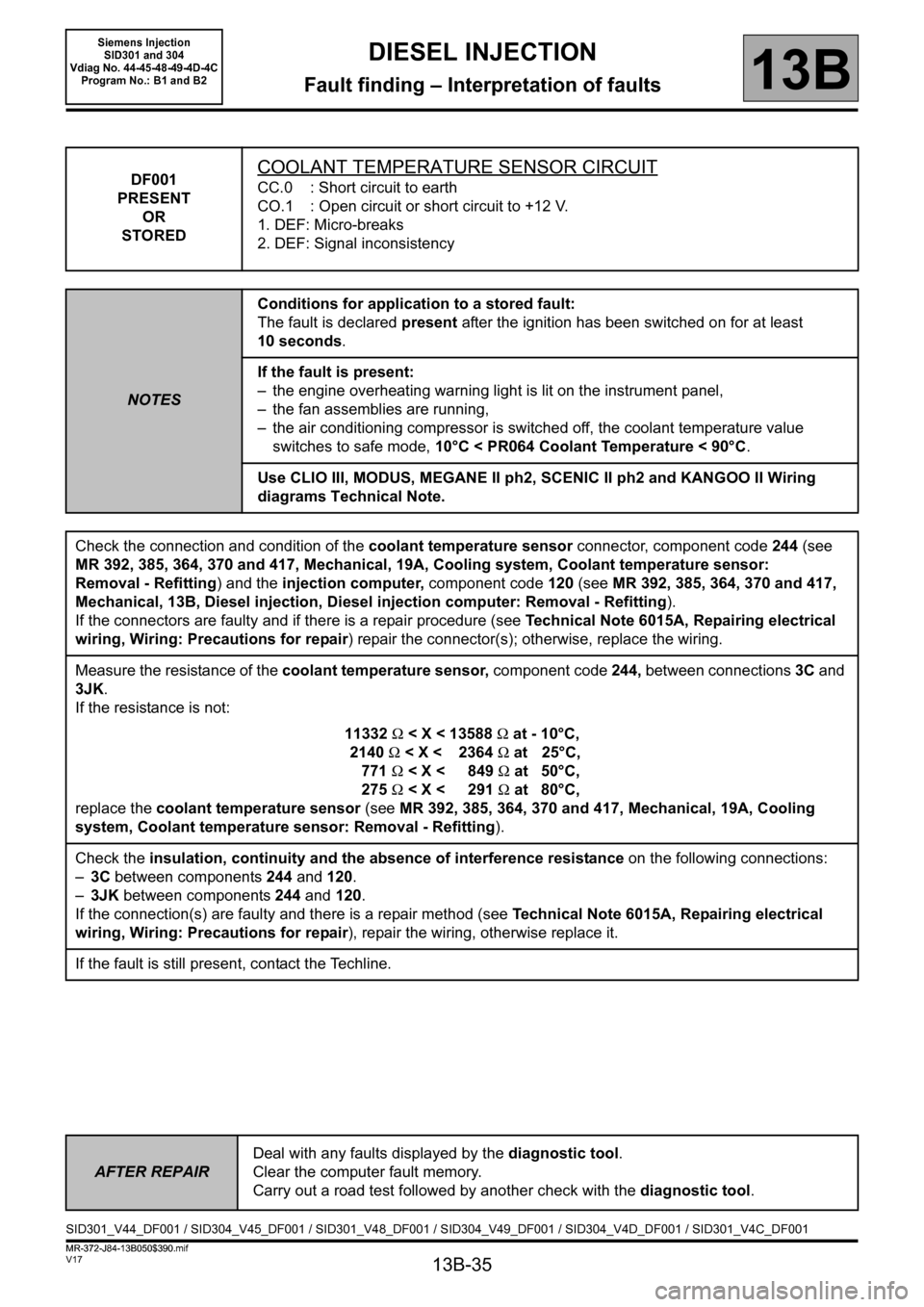
13B-35
MR-372-J84-13B050$390.mif
V17
13B
DIESEL INJECTION
Fault finding – Interpretation of faults
DF001
PRESENT
OR
STOREDCOOLANT TEMPERATURE SENSOR CIRCUIT
CC.0 : Short circuit to earth
CO.1 : Open circuit or short circuit to +12 V.
1. DEF: Micro-breaks
2. DEF: Signal inconsistency
NOTESConditions for application to a stored fault:
The fault is declared present after the ignition has been switched on for at least
10 seconds.
If the fault is present:
– the engine overheating warning light is lit on the instrument panel,
– the fan assemblies are running,
– the air conditioning compressor is switched off, the coolant temperature value
switches to safe mode, 10°C < PR064 Coolant Temperature < 90°C.
Use CLIO III, MODUS, MEGANE II ph2, SCENIC II ph2 and KANGOO II Wiring
diagrams Technical Note.
Check the connection and condition of the coolant temperature sensor connector, component code244 (see
MR 392, 385, 364, 370 and 417, Mechanical, 19A, Cooling system, Coolant temperature sensor:
Removal - Refitting) and the injection computer, component code120 (see MR 392, 385, 364, 370 and 417,
Mechanical, 13B, Diesel injection, Diesel injection computer: Removal - Refitting).
If the connectors are faulty and if there is a repair procedure (see Technical Note 6015A, Repairing electrical
wiring, Wiring: Precautions for repair) repair the connector(s); otherwise, replace the wiring.
Measure the resistance of the coolant temperature sensor, component code 244, between connections 3C and
3JK.
If the resistance is not:
11332Ω < X < 13588Ω at - 10°C,
2140Ω < X < 2364Ω at 25°C,
771Ω < X < 849Ω at 50°C,
275Ω < X < 291Ω at 80°C,
replace the coolant temperature sensor (see MR 392, 385, 364, 370 and 417, Mechanical, 19A, Cooling
system, Coolant temperature sensor: Removal - Refitting).
Check the insulation, continuity and the absence of interference resistance on the following connections:
–3C between components 244 and 120.
–3JK between components 244 and 120.
If the connection(s) are faulty and there is a repair method (see Technical Note 6015A, Repairing electrical
wiring, Wiring: Precautions for repair), repair the wiring, otherwise replace it.
If the fault is still present, contact the Techline.
AFTER REPAIRDeal with any faults displayed by the diagnostic tool.
Clear the computer fault memory.
Carry out a road test followed by another check with the diagnostic tool.
SID301_V44_DF001 / SID304_V45_DF001 / SID301_V48_DF001 / SID304_V49_DF001 / SID304_V4D_DF001 / SID301_V4C_DF001
MR-372-J84-13B050$390.mif
Siemens Injection
SID301 and 304
Vdiag No. 44-45-48-49-4D-4C
Program No.: B1 and B2
Page 36 of 329

13B-36
MR-372-J84-13B050$390.mif
V17
DIESEL INJECTION
Fault finding – Interpretation of faults
Siemens Injection
SID301 and 304
Vdiag No. 44-45-48-49-4D-4C
Program No.: B1 and B2
13B
DF003
PRESENT
OR
STOREDATMOSPHERIC PRESSURE SENSOR CIRCUIT
CC.1 : Short circuit to + 12 V
CO.0 : Open circuit or short circuit to earth
1. DEF: Micro-breaks
NOTESConditions for application to a stored fault:
The fault is declared present after the ignition has been switched on for at least
10 seconds.
If the fault is present:
– the OBD warning light is lit,
– small amount of smoke may be present,
– the atmospheric pressure value changes to safe mode, PR035 Atmospheric
pressure = 900 mbar.
Special notes:
The atmospheric pressure sensor is integrated into the injection computer and
cannot be separated.
Disconnect the injection computer, component code 120, and check the condition of the contacts and the
condition of its connector (see MR 392, 385, 364, 370 and 417, Mechanical, 13B, Diesel injection, Diesel
injection computer: Removal - Refitting).
If the connector is faulty and there is a repair procedure (see Technical Note 6015A, Electrical wiring repair,
Wiring: Precautions for repair), repair the connector, otherwise replace the wiring.
If the fault is still present, contact the Techline.
AFTER REPAIRDeal with any faults displayed by the diagnostic tool.
Clear the computer fault memory.
Carry out a road test followed by another check with the diagnostic tool.
SID301_V44_DF003 / SID304_V45_DF003 / SID301_V48_DF003 / SID304_V49_DF003 / SID304_V4D_DF003 / SID301_V4C_DF003
Page 37 of 329
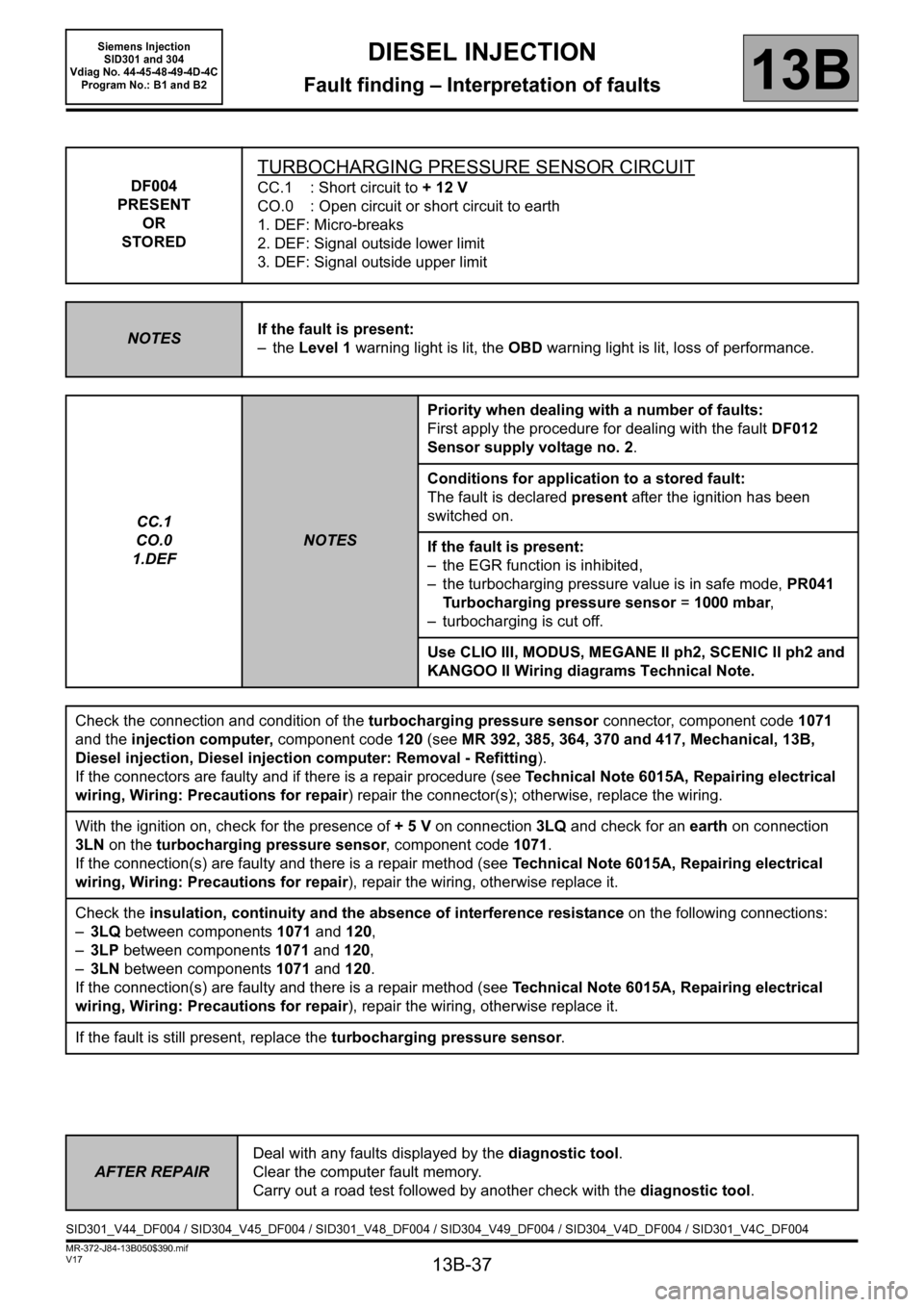
13B-37
MR-372-J84-13B050$390.mif
V17
DIESEL INJECTION
Fault finding – Interpretation of faults
Siemens Injection
SID301 and 304
Vdiag No. 44-45-48-49-4D-4C
Program No.: B1 and B2
13B
DF004
PRESENT
OR
STORED
TURBOCHARGING PRESSURE SENSOR CIRCUIT
CC.1 : Short circuit to + 12 V
CO.0 : Open circuit or short circuit to earth
1. DEF: Micro-breaks
2. DEF: Signal outside lower limit
3. DEF: Signal outside upper limit
NOTESIf the fault is present:
– the Level 1 warning light is lit, the OBD warning light is lit, loss of performance.
CC.1
CO.0
1.DEF
NOTESPriority when dealing with a number of faults:
First apply the procedure for dealing with the fault DF012
Sensor supply voltage no. 2.
Conditions for application to a stored fault:
The fault is declared present after the ignition has been
switched on.
If the fault is present:
– the EGR function is inhibited,
– the turbocharging pressure value is in safe mode, PR041
Turbocharging pressure sensor = 1000 mbar,
– turbocharging is cut off.
Use CLIO III, MODUS, MEGANE II ph2, SCENIC II ph2 and
KANGOO II Wiring diagrams Technical Note.
Check the connection and condition of the turbocharging pressure sensor connector, component code1071
and the injection computer, component code120 (see MR 392, 385, 364, 370 and 417, Mechanical, 13B,
Diesel injection, Diesel injection computer: Removal - Refitting).
If the connectors are faulty and if there is a repair procedure (see Technical Note 6015A, Repairing electrical
wiring, Wiring: Precautions for repair) repair the connector(s); otherwise, replace the wiring.
With the ignition on, check for the presence of + 5 V on connection 3LQ and check for an earth on connection
3LN on the turbocharging pressure sensor, component code 1071.
If the connection(s) are faulty and there is a repair method (see Technical Note 6015A, Repairing electrical
wiring, Wiring: Precautions for repair), repair the wiring, otherwise replace it.
Check the insulation, continuity and the absence of interference resistance on the following connections:
–3LQ between components 1071 and 120,
–3LP between components 1071 and 120,
–3LN between components 1071 and 120.
If the connection(s) are faulty and there is a repair method (see Technical Note 6015A, Repairing electrical
wiring, Wiring: Precautions for repair), repair the wiring, otherwise replace it.
If the fault is still present, replace the turbocharging pressure sensor.
AFTER REPAIRDeal with any faults displayed by the diagnostic tool.
Clear the computer fault memory.
Carry out a road test followed by another check with the diagnostic tool.
SID301_V44_DF004 / SID304_V45_DF004 / SID301_V48_DF004 / SID304_V49_DF004 / SID304_V4D_DF004 / SID301_V4C_DF004
Page 38 of 329

13B-38
MR-372-J84-13B050$390.mif
V17
DIESEL INJECTION
Fault finding – Interpretation of faults
Siemens Injection
SID301 and 304
Vdiag No. 44-45-48-49-4D-4C
Program No.: B1 and B2
13B
DF004
CONTINUED
2. DEF
3. DEF
NOTESPriority when dealing with a number of faults:
First deal with fault DF003 Atmospheric pressure sensor
circuit.
Conditions for application to a stored fault:
The fault is declared present after the ignition has been
switched on for 1 second, with a warm engine and when
the vehicle is stationary.
If the fault is present:
– the EGR function is inhibited,
– the turbocharging pressure value is in safe mode, PR041
Turbocharging pressure sensor = 1000 mbar,
– turbocharging is cut off.
– the maximum torque supplied by the engine is restricted.
Use CLIO III, MODUS, MEGANE II ph2, SCENIC II ph2 and
KANGOO II Wiring diagrams Technical Note.
Check the connection and condition of the turbocharging pressure sensor connector, component code1071
and the injection computer, component code120 (see MR 392, 385, 364, 370 and 417, Mechanical, 13B,
Diesel injection, Diesel injection computer: Removal - Refitting).
If the connectors are faulty and if there is a repair procedure (see Technical Note 6015A, Repairing electrical
wiring, Wiring: Precautions for repair) repair the connector(s); otherwise, replace the wiring.
With the ignition on, check for the presence of + 5 V on connection 3LQ and check for an earth on connection
3LN on the turbocharging pressure sensor, component code 1071.
If the connection(s) are faulty and there is a repair method (see Technical Note 6015A, Repairing electrical
wiring, Wiring: Precautions for repair), repair the wiring, otherwise replace it.
Check the insulation, continuity and the absence of interference resistance on the following connections:
–3LQ between components 1071 and 120,
–3LP between components 1071 and 120,
–3LN between components 1071 and 120.
If the connection(s) are faulty and there is a repair procedure (see Technical Note 6015A, Repairing electrical
wiring, Wiring: Precautions for repair), repair the wiring, otherwise replace it.
If the connections are correct, replace the turbocharging pressure sensor
If the fault is still present, contact the Techline.
AFTER REPAIRDeal with any faults displayed by the diagnostic tool.
Clear the computer fault memory.
Carry out a road test followed by another check with the diagnostic tool.
Page 39 of 329

13B-39
MR-372-J84-13B050$390.mif
V17
DIESEL INJECTION
Fault finding – Interpretation of faults
Siemens Injection
SID301 and 304
Vdiag No. 44-45-48-49-4D-4C
Program No.: B1 and B2
13B
DF005
PRESENT
OR
STORED
ENGINE SPEED SENSOR CIRCUIT
1. DEF: Signal inconsistency
2. DEF: No signal
3. DEF: Signal outside upper limit
4. DEF: Values outside limits
5. DEF: Configuration/Initialisation
6. DEF: Inconsistent data
NOTESConditions for applying the fault finding procedure to a stored fault:
The fault is declared present with the engine under the starter or when idling.
Special notes:
Level 2 warning light illuminated in instrument panel, engine stalls or cannot be
(re)started.
The ESP function is inhibited. The ESP function is inhibited.
Use CLIO III, MODUS, MEGANE II ph2, SCENIC II ph2 and KANGOO II Wiring
diagrams Technical Note.
Check the connection and condition of the TDC sensor connector, component code 149.
If the connector is faulty and there is a repair procedure (see Technical Note 6015A, Electrical wiring repair,
Wiring: Precautions for repair), repair the connector, otherwise replace the wiring.
Ensure the sensor is correctly fitted to the engine.
Measure the resistance between connections3BG and 3BL of the TDC Sensor, component code149.
If the resistance is not between 510Ω and 850Ω, replace the TDC sensor, component code149.
Check the connection and condition of the injection computer connector, component code120 (see MR 392,
385, 364, 370 and 417, Mechanical, 13B, Diesel injection, Diesel injection computer: Removal - Refitting).
If the connector is faulty and there is a repair procedure (see Technical Note 6015A, Electrical wiring repair,
Wiring: Precautions for repair), repair the connector, otherwise replace the wiring.
Check the insulation, continuity and the absence of interference resistance on the following connections:
–3BG between components 149 and 120,
–3BL between components 149 and 120.
If the connection(s) are faulty and there is a repair method (see Technical Note 6015A, Repairing electrical
wiring, Wiring: Precautions for repair), repair the wiring, otherwise replace it.
Check that the flywheel target is not faulty (missing teeth).
AFTER REPAIRDeal with any faults displayed by the diagnostic tool.
Clear the computer fault memory.
Carry out a road test followed by another check with the diagnostic tool.
SID301_V44_DF005 / SID304_V45_DF005 / SID301_V48_DF005 / SID304_V49_DF005 / SID304_V4D_DF005 / SID301_V4C_DF005
Page 40 of 329
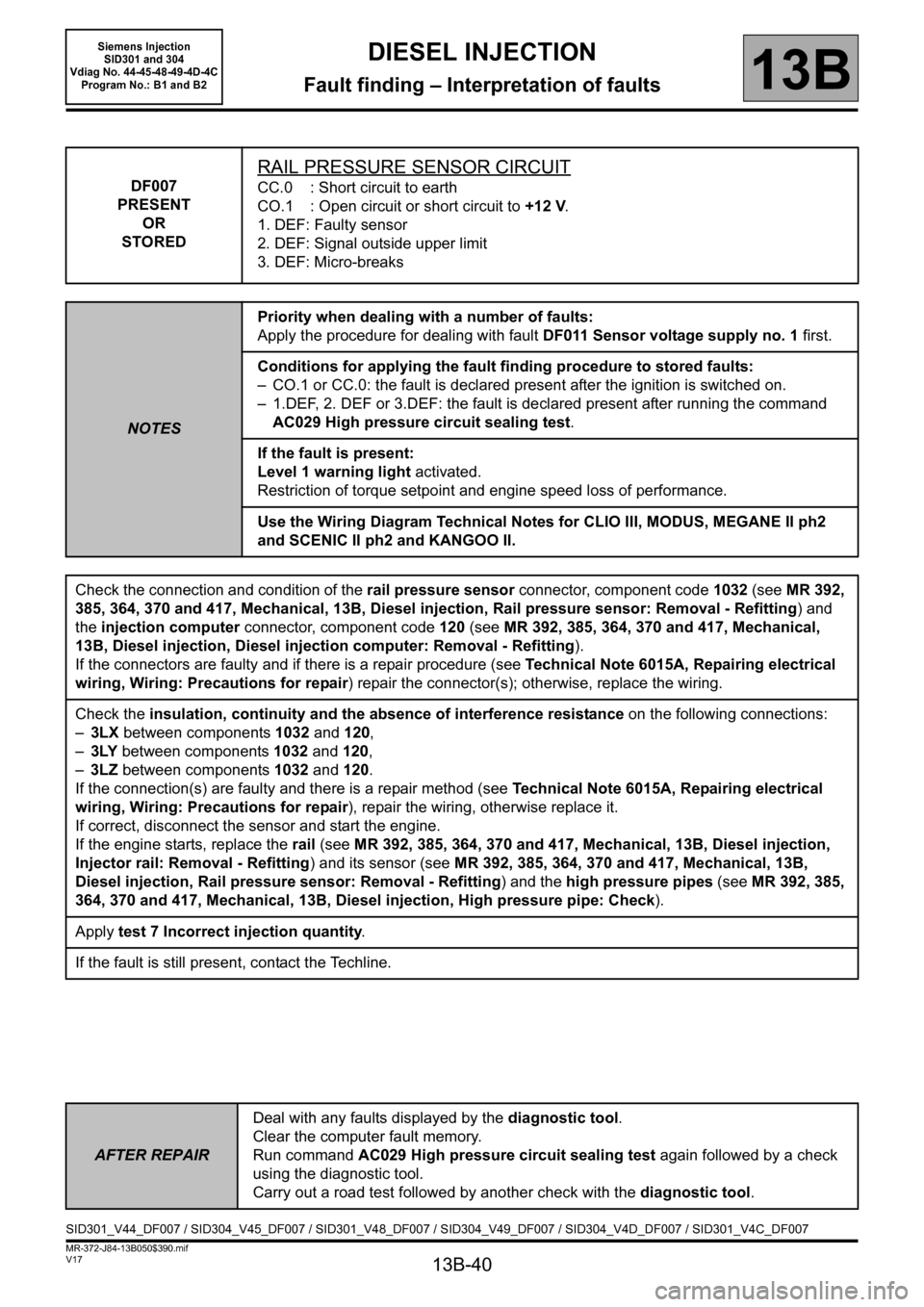
13B-40
MR-372-J84-13B050$390.mif
V17
DIESEL INJECTION
Fault finding – Interpretation of faults
Siemens Injection
SID301 and 304
Vdiag No. 44-45-48-49-4D-4C
Program No.: B1 and B2
13B
DF007
PRESENT
OR
STORED
RAIL PRESSURE SENSOR CIRCUIT
CC.0 : Short circuit to earth
CO.1 : Open circuit or short circuit to +12 V.
1. DEF: Faulty sensor
2. DEF: Signal outside upper limit
3. DEF: Micro-breaks
NOTESPriority when dealing with a number of faults:
Apply the procedure for dealing with fault DF011 Sensor voltage supply no. 1 first.
Conditions for applying the fault finding procedure to stored faults:
– CO.1 or CC.0: the fault is declared present after the ignition is switched on.
– 1.DEF, 2. DEF or 3.DEF: the fault is declared present after running the command
AC029 High pressure circuit sealing test.
If the fault is present:
Level 1 warning light activated.
Restriction of torque setpoint and engine speed loss of performance.
Use the Wiring Diagram Technical Notes for CLIO III, MODUS, MEGANE II ph2
and SCENIC II ph2 and KANGOO II.
Check the connection and condition of the rail pressure sensor connector, component code1032 (see MR 392,
385, 364, 370 and 417, Mechanical, 13B, Diesel injection, Rail pressure sensor: Removal - Refitting) and
the injection computer connector, component code120 (see MR 392, 385, 364, 370 and 417, Mechanical,
13B, Diesel injection, Diesel injection computer: Removal - Refitting).
If the connectors are faulty and if there is a repair procedure (see Technical Note 6015A, Repairing electrical
wiring, Wiring: Precautions for repair) repair the connector(s); otherwise, replace the wiring.
Check the insulation, continuity and the absence of interference resistance on the following connections:
–3LX between components 1032 and 120,
–3LY between components 1032 and 120,
–3LZ between components 1032 and 120.
If the connection(s) are faulty and there is a repair method (see Technical Note 6015A, Repairing electrical
wiring, Wiring: Precautions for repair), repair the wiring, otherwise replace it.
If correct, disconnect the sensor and start the engine.
If the engine starts, replace the rail (see MR 392, 385, 364, 370 and 417, Mechanical, 13B, Diesel injection,
Injector rail: Removal - Refitting) and its sensor (see MR 392, 385, 364, 370 and 417, Mechanical, 13B,
Diesel injection, Rail pressure sensor: Removal - Refitting) and the high pressure pipes (see MR 392, 385,
364, 370 and 417, Mechanical, 13B, Diesel injection, High pressure pipe: Check).
Apply test 7 Incorrect injection quantity
.
If the fault is still present, contact the Techline.
AFTER REPAIRDeal with any faults displayed by the diagnostic tool.
Clear the computer fault memory.
Run command AC029 High pressure circuit sealing test again followed by a check
using the diagnostic tool.
Carry out a road test followed by another check with the diagnostic tool.
SID301_V44_DF007 / SID304_V45_DF007 / SID301_V48_DF007 / SID304_V49_DF007 / SID304_V4D_DF007 / SID301_V4C_DF007
Page 41 of 329

13B-41
MR-372-J84-13B050$390.mif
V17
DIESEL INJECTION
Fault finding – Interpretation of faults
Siemens Injection
SID301 and 304
Vdiag No. 44-45-48-49-4D-4C
Program No.: B1 and B2
13B
DF008
PRESENT
OR
STOREDPEDAL POTENTIOMETER CIRCUIT GANG 1
CC.1 : Short circuit to + 12 V
CO.0 : Open circuit or short circuit to earth
1. DEF: Signal inconsistency
2. DEF: No signal
NOTESPriorities when dealing with a number of faults:
If fault DF009 Pedal potentiometer circuit gang 2 is present at the same time,
check that the pedal sensor connector is connected correctly.
First deal with the fault DF012 Sensor supply voltage no. 2 if the fault is present or
stored.
Conditions for applying the fault finding procedure to stored faults:
The fault is declared present after a series of full-load/no-load actions on the
accelerator pedal.
Special notes:
Restriction of idle speed setpoint, loss of performance and non-authorised speed
regulation.
Level 1 or 2 warning light is lit.
Possibility of engine speed regulation at 1800 rpm 42 mph (70 km/h) when
accelerating (39 mph (65 km/h) when decelerating) and then speed regulated to
48 mph (80 km/h) beyond that.
Use CLIO III, MODUS, MEGANE II ph2, SCENIC II ph2 and KANGOO II Wiring
diagrams Technical Note.
Check the connection and condition of the accelerator pedal potentiometer connector, component code921
(see MR 392, 385, 364, 370 and 417, Mechanical, 13B, Diesel injection, Accelerator pedal potentiometer:
Removal - Refitting) and the injection computer, component code120 (see MR 392, 385, 364, 370 and 417,
Mechanical, 13B, Diesel injection, Diesel injection computer: Removal - Refitting).
If the connectors are faulty and if there is a repair procedure (see Technical Note 6015A, Repairing electrical
wiring, Wiring: Precautions for repair) repair the connector(s); otherwise, replace the wiring.
Measure the resistance of the pedal potentiometer on gang 1 between connections3LT and 3LR.
If the resistance is not between 0.8 kΩ and
2.6 kΩ, replace the pedal potentiometer (see MR 392, 385, 364,
370 and 417, Mechanical, 13B, Diesel injection, Accelerator pedal potentiometer: Removal - Refitting).
With the ignition on, check for the presence of + 5 V on connection 3LR and check for an earth on connection
3LT of the pedal potentiometer, component code 921.
If the connection(s) are faulty and there is a repair method (see Technical Note 6015A, Repairing electrical
wiring, Wiring: Precautions for repair), repair the wiring, otherwise replace it.
AFTER REPAIRDeal with any faults displayed by the diagnostic tool.
Clear the computer fault memory.
Carry out a road test followed by another check with the diagnostic tool.
SID301_V44_DF008 / SID304_V45_DF008 / SID301_V48_DF008 / SID304_V49_DF008 / SID304_V4D_DF008 / SID301_V4C_DF008